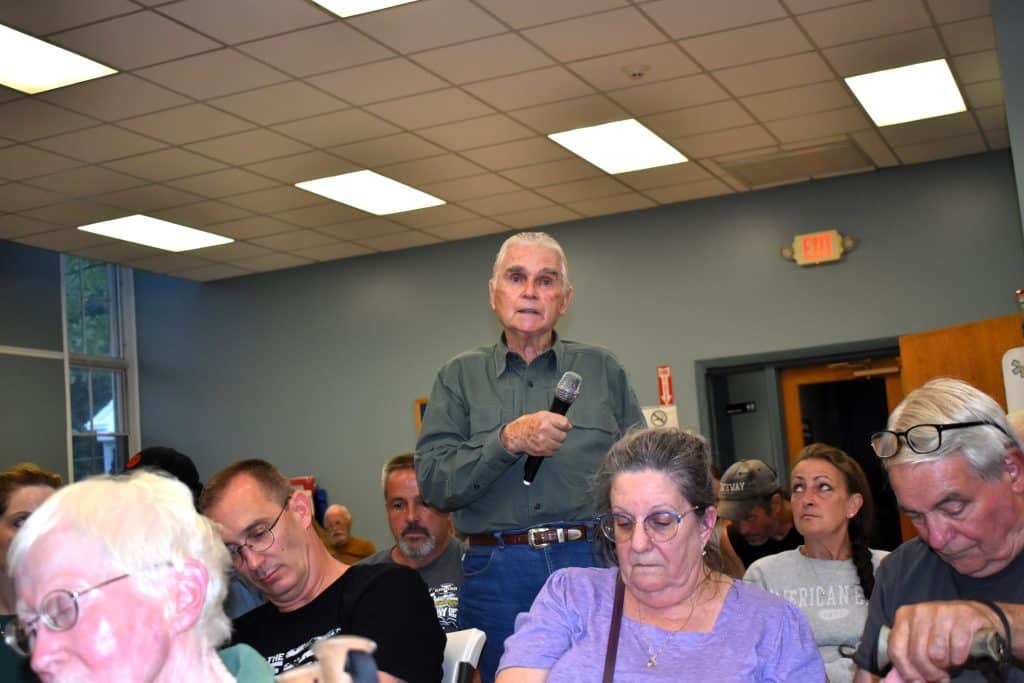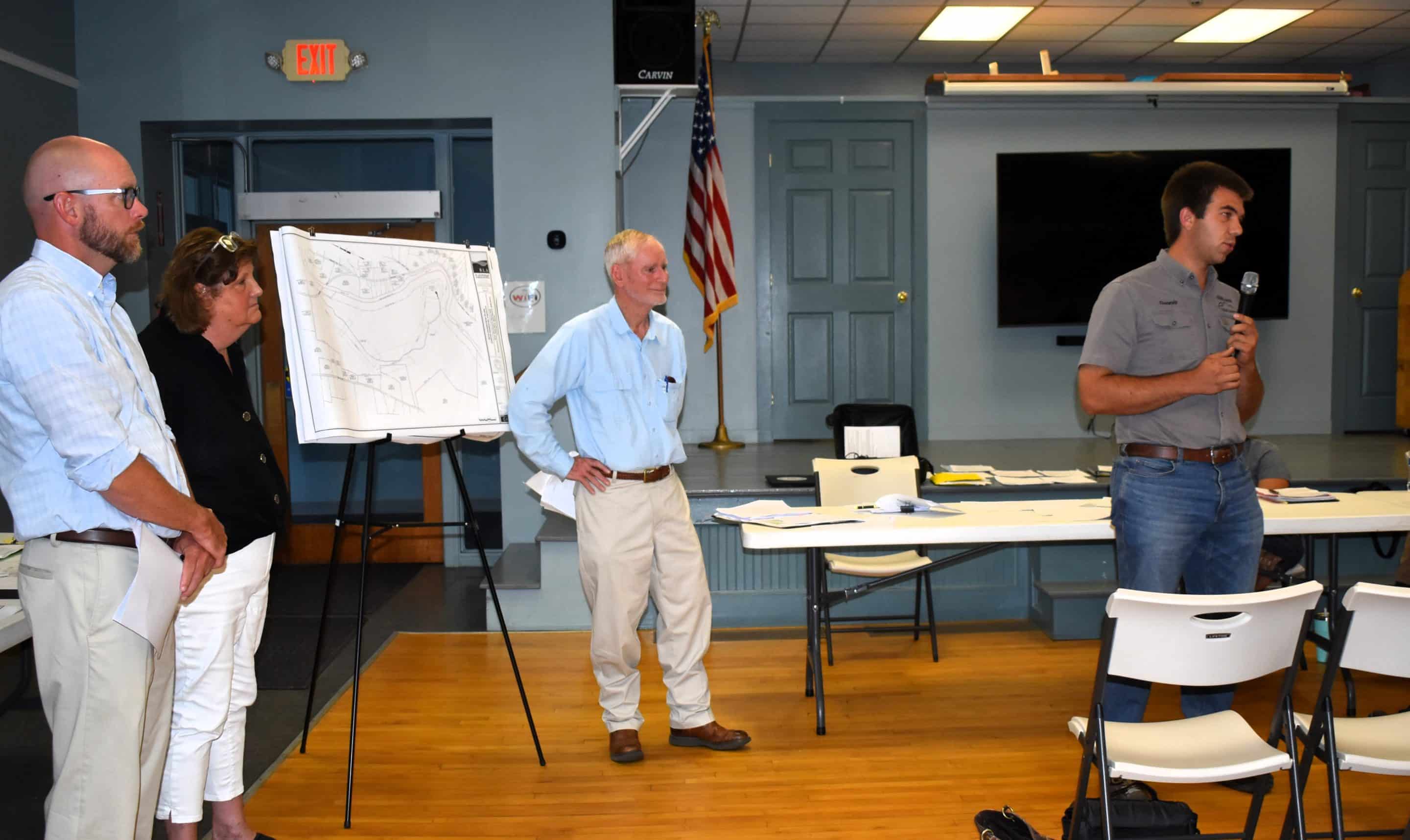From left, Rob Levesque of R. Levesque Associates, Huntington Zoning Board Chair Karon Hathaway, William Hull and Dennis Nolt of Hilltown Sand & Gravel discuss the gravel pit project at an Aug. 13 public hearing in Stanton Hall.
Reminder Publishing photo by Amy Porter
HUNTINGTON — A third public hearing on Aug. 13 in Stanton Hall for a special permit for a proposed 4.9-acre gravel pit at 61 Goss Hill Rd., and properties off Goss Hill Road and Worthington Road, on land owned by William B. Hull Forestlands, ended with a continuance and a tentative scheduled date for another hearing on Nov. 12.
The gravel pit would be located 250 feet west of the Westfield River approximately across the river from the Rapids Restaurant, with an access road that would enter and exit on Route 112 between Nagler Cross Road and the bridge above the entrance to the Knightville Dam.

Reminder Publishing photo by Amy Porter
Hull said his intention is to have Hilltown Sand & Gravel purchase and excavate the gravel for its business at 87 Worthington Rd. Hull, who owns 1,300 acres of forestland in Huntington, said the income from the gravel pit would fund the maintenance of the forests. Dennis Nolt of Hilltown Sand & Gravel was also present at the meeting, as was lawyer Michael Pill of Green Miles Lipton LLP in Northampton, representing Hull Forestlands.
Rob Levesque of R. Levesque Associates, a landscape architect and civil engineering firm in Westfield, presented the project for Hull. The hearing was well attended by residents, all but one of whom spoke against the proposal.
Levesque began by running down answers to questions previously submitted by the Zoning Board of Appeals, chaired by Karon Hathaway, the permitting body for the application.
Levesque said the board had initially requested two studies, on noise and traffic, but had increased its request to nine, including impacts on the aquifer, silica dust, endangered species, archeological, diesel impact, hydrological studies and property values.
He said the town had to date been unable to secure a traffic consultant.
Hathaway said the town had contacted the Massachusetts Department Of Transportation, but had not heard back. She said the town is concerned about the line of sight on Route 112 for trucks traveling south on the state highway and for trucks exiting the access road, which she said is short.
Levesque said MassDOT would not do a traffic study; the town would need an independent consultant. He said he would provide a list of consultants. He said it would be trickier to find a noise consultant, but would provide the town with some names.
Levesque said other studies are not applicable to the site. He said the aquifer is two and a half miles from the site “as the crow flies.” Regarding endangered species, he said the National Heritage Endangered Species program does not have the area marked on its maps, and it also does not fall within a mapped archeological site.
Levesque said a hydrological study could be done, but since the gravel pit will create a pervious, not impervious surface, his guess would be that it would reduce runoff. He said R. Levesque Associates could perform that study itself.
As for a silica dust study, Levesque suggested that the Zoning Board could make it a condition of its special permit that operations cannot add dust to the air.
Hathaway said she had asked Zoning Board member Victoria Minella-Sena, a Realtor, to look at the impact on property values.
Minella-Sena said there is a lot of information on Google regarding property values and proximity to gravel pits. She said some studies suggest a 20% to 30% reduction in value for abutters, and up to a 7% reduction within 3 miles, although she said she had not done the study herself.
“I guess we could gauge that by how residents in the town feel,” Minella-Sena said, adding that contradictory studies say there is no impact. She said it is subjective, but there is the potential for impact on property values.
Levesque said the site would be 250 feet from the river with a 200-foot forested buffer that will be maintained pristine. He said there would be 32 truck trips per week, not per day, which he said was an error in previously submitted paperwork.
He said regarding ground water, a study had been done in 2015, and geology doesn’t change in 10 years. He said the study did locate the mean high water line, and the river is generally in the same location, with nothing new to report.
Many residents who spoke at the hearing remained concerned about the impact of the excavation on their quality of life, particularly regarding noise and the impact of silica dust, a known carcinogen, from the excavation.
“You’re minimizing the real threat of silica on people. I don’t believe you don’t know the threat of silica,” said Esther Baillargeon of Goss Hill Road, adding that she believed the school yard would be affected as well. The Gateway campus is about a mile and a half away.
Other residents said the noise is what they were worried about. Ellen Davis of Nagler Cross Road said she moved to Huntington because it was quiet.
Hull assured residents that there would be no blasting onsite, and Hathaway said the Zoning Board could make “no blasting” a condition of its approval.
Longtime Goss Hill Road resident Ed Grabowski said that years ago, a group of residents had hired Hull’s attorney Michael Pill to fight a former gravel pit application in the area. He said Pill had previously said due to the location of that gravel pit in the wetlands and on the bank of the Westfield River, the application should be denied.
Pill said the former gravel pit had a different access road. He said if the current project were going in a wetland, he wouldn’t be a part of it.
Grabowski noted that Gardner State Park, which abuts the proposed gravel pit, is still there.
Cathy Brisboise of Goss Hill Road said Hull’s access road is 400 feet in back of her house with no buffer.
“I can hear a dog barking next to Rapids Restaurant. I didn’t buy a house next to a gravel pit; you want to put a gravel pit next to my house,” said Michael Brisboise. He also said a gravel pit looks like “scorched earth” when it’s done, even after reclamation work.
“I was on the Planning Board. Very few other pits had the visibility of this one,” Brisboise said, adding, “Is there actually any benefit to Huntington at all?”
Several other residents asked how the town would benefit, questioning what income and taxes the town would get by granting the permit.
Planning Board Chair Linda Hamlin said if it’s a wholesale operation, Hull would not pay taxes on the sale of the gravel. Hilltown Sand & Gravel would pay retail sales tax on the additional product. She said they also pay property tax, in response to a suggestion that they had a religious exemption.
“We pay as much taxes as any other businesses or people — property tax, sales tax,” said Nolt. He said that Hilltown Sand & Gravel sells the product to the Huntington Highway Department at a discounted municipal rate.
John Garriepy, who said he grew up near Donovan Sand & Gravel and “listened to it every day of [his] life,” said he has lived for the past 32 years on Goss Hill Road. He said in his opinion, the area is not zoned for a gravel pit.
“I have my own well. Noise is a factor. I’m not in favor of deforesting the land,” he said. “Basically, my feeling is if the town doesn’t grant this permit, we have no worries. Only two people benefit — Hull and Hilltown Sand & Gravel. I assume Hull’s property is Chapter 61.”
Chapter 61 of state law gives a preferential tax rate for property maintained as open space for timber or agriculture. Hull said his property is in Chapter 61.
Garriepy revealed that he is a stage 4 cancer patient currently under treatment with tumors in his body and his lungs from years of working with firefighting foam.
“Do you think I want to take a risk?” he asked, referring to exposure to silica.
Charles MacDonald said 20 years ago it was determined that there could be sand and gravel on his 200 acres at the end of Sampson Road. “I had the right to earn money” on his own property, MacDonald said, and in the end he was awarded Massachusetts Tree Farmer of the Year.
“I had the same thing,” he said. “Everything was done by the rules. All this concern, preventing Bill from his right to earn money from material on the land. I give complete support to Bill Hull. I went through this — as time goes by, no one’s complaining any more. Take the weeds out of your gardens. You set the rules. Rules are here to be followed.”
“If this goes through, if there’s any real racket, it will affect us,” said Gary Cole of Nagler Cross Road. “What is this going to look like if it goes through when it’s done?”
MacDonald said after the sand and gravel is removed, the topsoil is saved. The owner gives the town a monetary bond, and when extraction activities are finished, the soil is replaced. Until then, the town holds onto the bond. He said Hull is a responsible landowner.
Levesque said the town bylaws require that the land is restored. He said the bond ensures restoration, which is typically replacing the topsoil, regrading and planting.
Grabowski said he used to be on the Planning Board.
“Mr. MacDonald’s gravel pit was way out in the woods — forests. This gravel pit is in a very different area. It’s in an amphitheatre,” he said, adding, “I knew nothing about silica dust before these meetings.”



